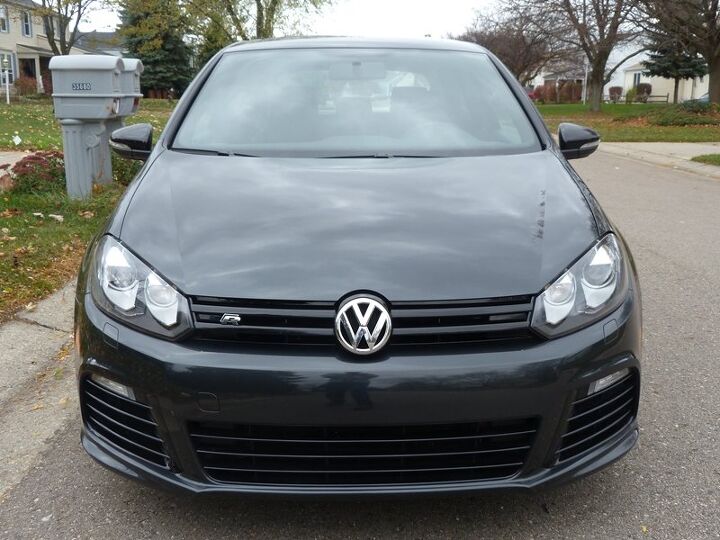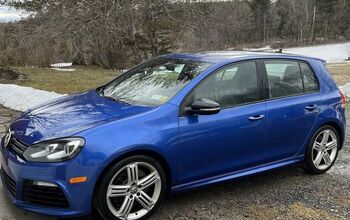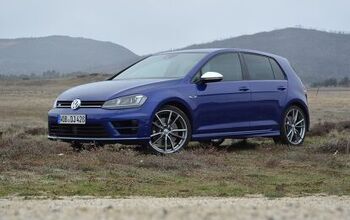Review: 2012 Volkswagen Golf R (US-spec)
Take the iconic Volkswagen GTI. Add a larger turbo to the 2.0-liter engine to bump the official horsepower rating from 200 to 256. Add all-wheel-drive to mitigate torque steer. The resulting Golf R ought to be hot hatch nirvana. Jack Baruth found something else. But he drove a Euro-spec car. Perhaps VW performed some beneficial tweaks with the Americanized version?
The GTI looks too wild for your tastes? You should find the Golf R more suitable. Outside, the GTI’s red grille trim, red calipers, and highly-styled rims have been replaced by much more subtle bits. The R does have larger lower front fascia openings, side skirts, and a centrally-located dual exhaust, but these are sufficiently restrained that only the VW cognoscenti will likely notice them. (When they do you’ll get a thumbs-up.) The rest of the population will see just another GTI, if they notice the Golf R at all. If you’ve been inside a GTI with the Autobahn Package’s black leather interior, you’ve essentially been inside this car. The taste police simply replaced the GTI’s red instrument needles and stitching with blue and white, respectively. It’s as if they wanted others to see a regular Golf, which might (together with the possibility of a lawsuit) explain why the nameplate reads “Golf R” rather than “GTI-R.” Do sleepers excite you, or put you to sleep?
Interior functionality is identical to the GTI. Compared to a Focus ST, room for elbows and knees seems more abundant and the car feels larger. The front seats provide good lateral support and comfort—with one possible exception. I couldn’t adjust the power four-way lumbar support so it did less harm than good with my particular lower back. Opt for the four-door, and the seats lose the power four-way lumbar (in favor of manual two-way) but gain power recline. With either body style the seats have a single manual height adjustment, so there’s no way to separately adjust their tilt. R-exclusive amenities are limited to headlight washers and dual-zone automatic climate control. Automatic headlights are not available. Keyless ignition is standard, but unlike with most such systems you must keep your finger on the button until the engine is spinning. (Even at the end of my week with the R I kept forgetting this.) Otherwise, ergonomics are quite good, with simple, easy to understand and operate controls.
Any sleeper worthy of the name combines invisible styling with strong performance. The Golf R has the former. Towards the latter, on paper the car has 56 more horsepower (256 @ 6,000 rpm vs. 207 @ 5,100 rpm) and 36 more pound-feet of torque (243 @ 2,400 rpm vs. 207 @ 1,700 rpm) than the regular 2.0T mill. In reality, the lesser engine outperforms its specs to such a degree that, if you remove traction off the line from the equation, the GTI gets to 60 about as quickly as the 291-pound-porkier Golf R (Car and Driver‘s 5-to-60 “street start” is seven seconds flat for both). As speed increases, the Golf R does gain strength, and once over 60 it would leave a GTI increasingly farther behind while sounding especially good for a four. At lower speeds its greater reliance on boost is readily evident. The mandatory six-speed manual’s shifter isn’t far removed from standard Wolfsburg issue, with longish throws, notchy engagements, and a touch of slop.
The Golf R’s more powerful engine, all-wheel-drive, and higher curb weight take a toll on fuel economy, reducing the EPA ratings from 21 mpg city, 31 mpg highway to 19/27. The trip computer (which might or might not be accurate) reported 26 mpg with a light foot in suburban driving, and low 20s with a heavier foot.
Throw the Golf R through some curves, and its reason for being becomes even harder to discern. The stability control cannot be defeated, or even dialed back. Combine this with the all-wheel-drive system, and the chassis is stable to a fault, going where you want it to but not interested in any dancing. The only available, decidedly non-Autobahn tires, H-rated all-seasons, don’t feel sharp or grippy. Little of what they communicate survives the trip through the electrically-assisted steering system to an overly large flat-bottomed wheel. (The high effort criticized by Jack in the Euro-spec car appears to have been Americanized away.)
Virtually nothing about how the Golf R drives suggests a special performance variant. The edginess and immediacy of an Evo is absent. On the flip side, the Golf R’s ride is far smoother and quieter than the Mitsubishi’s. But a Focus ST is much more fun to drive than the uber-Golf while being nearly as civilized.
For die-hard fans of the brand, the Golf R’s $5,495 premium over a leather-trimmed GTI seems well worth it. Overlooking that feature differences aside from the engine account for only about $2,300 of this difference (according to TrueDelta’s car price comparison tool), said GTI is already quite pricey for a compact car without a fancy label. So the Golf R starts at $34,785 (up $25 from the tested 2012). Add $600 for a second pair of doors (not on the tested car). Add $1,500 for sunroof and nav. Start thinking of what else you could get for nearly $37,000.
At this price, all but the truest VW fans will want more striking styling, quicker acceleration, more engaging handling or more extensive amenities—perhaps even all of the above—than the Golf R offers. It’s not necessary to go crazy with the styling or the tuning; taken too far, these also limit the appeal of a car. The broader Volkswagen group knows how to pair an exhilarating driving experience with tasteful styling and a high degree of livability. Among similarly configured cars, they did it with the Audi TT RS. They just didn’t do it here. Maybe in Europe the Golf R somehow makes sense. For enthusiasts playing the field on this side of the Atlantic, they didn’t tweak it enough.
[Note: Some very insightful comments from Charlie84 below point out that 1) the Golf R’s engine is far more solidly built than it needs to be for 256 horsepower, 2) it’s easy to modify this engine to produce over 300 wheel horsepower (so about 350 at the crank), and 3) the car is far more fun once this is done. This implies that VW intended for owners to modify the car. So why not just provide more power stock? Some possible reasons: 1) durability (of driveline components if not the engine itself), 2) fuel economy, or 3) marketing, as a more powerful car might be seen as treading on Audi’s turf.]
Volkswagen provided an insured vehicle with a tank of gas.
Michael Karesh operates TrueDelta.com, an online source of car reliability and pricing information.
Michael Karesh lives in West Bloomfield, Michigan, with his wife and three children. In 2003 he received a Ph.D. from the University of Chicago. While in Chicago he worked at the National Opinion Research Center, a leader in the field of survey research. For his doctoral thesis, he spent a year-and-a-half inside an automaker studying how and how well it understood consumers when developing new products. While pursuing the degree he taught consumer behavior and product development at Oakland University. Since 1999, he has contributed auto reviews to Epinions, where he is currently one of two people in charge of the autos section. Since earning the degree he has continued to care for his children (school, gymnastics, tae-kwan-do...) and write reviews for Epinions and, more recently, The Truth About Cars while developing TrueDelta, a vehicle reliability and price comparison site.
More by Michael Karesh
Latest Car Reviews
Read moreLatest Product Reviews
Read moreRecent Comments
- JMII I did them on my C7 because somehow GM managed to build LED markers that fail after only 6 years. These are brighter then OEM despite the smoke tint look.I got them here: https://www.corvettepartsandaccessories.com/products/c7-corvette-oracle-concept-sidemarker-set?variant=1401801736202
- 28-Cars-Later Why RHO? Were Gamma and Epsilon already taken?
- 28-Cars-Later "The VF 8 has struggled to break ground in the increasingly crowded EV market, as spotty reviews have highlighted deficiencies with its tech, ride quality, and driver assistance features. That said, the price isn’t terrible by current EV standards, starting at $47,200 with leases at $429 monthly." In a not so surprising turn of events, VinFast US has already gone bankrupt.
- 28-Cars-Later "Farley expressed his belief that Ford would figure things out in the next few years."Ford death watch starts now.
- JMII My wife's next car will be an EV. As long as it costs under $42k that is totally within our budget. The average cost of a new ICE car is... (checks interwebs) = $47k. So EVs are already in the "affordable" range for today's new car buyers.We already have two other ICE vehicles one of which has a 6.2l V8 with a manual. This way we can have our cake and eat it too. If your a one vehicle household I can see why an EV, no matter the cost, may not work in that situation. But if you have two vehicles one can easily be an EV.My brother has an EV (Tesla Model Y) along with two ICE Porsche's (one is a dedicated track car) and his high school age daughters share an EV (Bolt). I fully assume his daughters will never drive an ICE vehicle. Just like they have never watched anything but HiDef TV, never used a land-line, nor been without an iPad. To them the concept of an ICE power vehicle is complete ridiculous - you mean you have to STOP driving to put some gas in and then PAY for it!!! Why? the car should already charged and the cost is covered by just paying the monthly electric bill.So the way I see it the EV problem will solve itself, once all the boomers die off. Myself as part of Gen X / MTV Generation will have drive a mix of EV and ICE.







































Comments
Join the conversation
I currently own a 2007 GTI w/DSG and the Package 2 interior (essentially the same package they now call "Autobahn"). Stage-I APR software, upgraded DV and CAI are my only mods. I test drove the new R just for kicks and to see how different it was - I wasn't even remotely interested in buying one, mind you. A couple thoughts: 1. It's definitely faster, but the power seems less accessible in daily driving situations. As in: driving around the city at sane speeds. I had to take the R on the highway to realize its potential. To be fair, I was also a bit rusty on driving a manual, so take it for what it's worth, I guess. 2. Handling feels basically the same as it does in my present GTI. To be honest, I'm not really surprised. The overall utility offered by AWD is relatively moot where I live (Phoenix metro). Granted, you do get more traction for those extra ponies. But from a pure performance point of view, my thinking is that unless you plan on tuning this car beyond factory spec, you could probably live without the AWD. Would I pay $35k+ for this car? Probably not. I can see where it may be a no-brainer upgrade for enthusiasts, versus an Autobahn package GTI (those can easily command $31-32k new off a lot, the way dealers option them), but I will also contend that add-on options make VWs a lot more expensive than they should be. You can buy a lightly used 3-Series for the same money. I only bought a loaded GTI back in 2007 because a) I got a smoking deal; and b) it was the end of the model year and it was impossible to find a stripper model with 18" wheels and a sunroof. So, I spent about $2000 more than I wanted to, but oh well - I still love my car. But the main point here is that best value sporty car you can get from VW is still the base GTI. Based on my observations, it's 85-90% of the car the R is for a lot less money. To me, spending over $30k for a hatchback VW borders on the insane.
As an owner of a GTI (dsg, 5 door, Stage 1+) and now an audi S3 Stage 2+(manual three door) I will add: The tuning of the S3 added a little under 50% more power (pre and post dyno). So not 400hp, but not too far off it. To the ignoramus above who thinks this type of tuning makes the car less driveable i assure you that you are wrong. The tuned car is better in every possible way. It is not louder, it gets better fuel economy, the awd system starts to make sense, it is far less laggy. The tuned GTI was crap. front wheel drive cant handle the kind of torque that the car makes tuned. Meanwhile the S3/R becomes great fun. Hard corner exits get the awd working and suddenly it worth having and you are moving at a speed a gti can only dream of. To the other ignoramus that thinks tuning a gti and a golf r is the same in terms of power increases- think again. Having done both the R/S3 motors have a lot more power waiting to be unleashed than the gti. *I am in australia, so I wont comment on the rrp of the 2 cars in the U.S. Down here cars are MUCH more expensive than in the U.S.